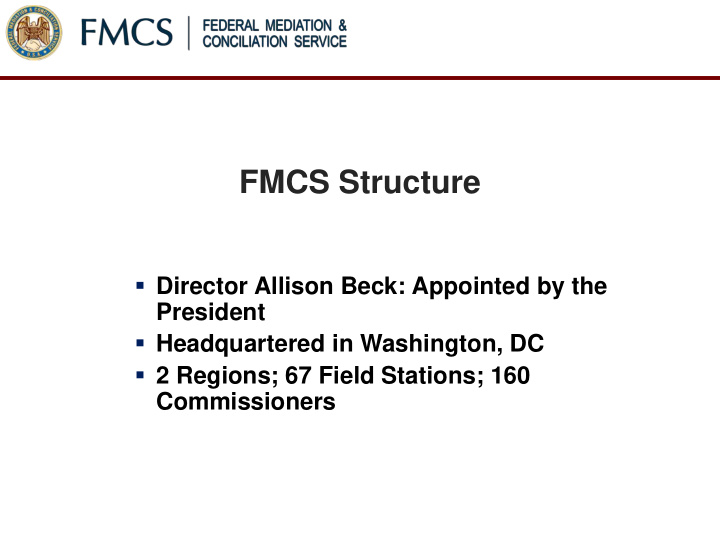



FMCS Structure Director Allison Beck: Appointed by the President Headquartered in Washington, DC 2 Regions; 67 Field Stations; 160 Commissioners
FMCS Services • Collective Bargaining Mediation • Private, Public, and Federal • Relationship Development and Training • Customized training • Arbitration Services • Education, Outreach and Advocacy • Of collective bargaining processes • Alternative Dispute Resolution • In-lieu of litigation • International Program
FMCS • The Federal Mediation and Conciliation Service was established as an independent agency by the Labor- Management Relations Act of 1947 (Taft-Hartley Act) • It was created to resolve collective bargaining disputes • to promote sound and stable labor-management relations 3
FMCS (continued) • The services address three mutual goals: - Improving the Labor-Management Relationship - Improving Organizational Effectiveness and Employment Security - Improving Community Relations 4
5
What is Communication? • Process of keeping people informed • Transfer of knowledge from one person to another • Process that can be used to motivate or change behavior
Communication • Impacts – Job Satisfaction – Productivity – Turnover – Absenteeism • Promote an environment of “Open Communication”
What is Communication? • Process of keeping people informed • Transfer of knowledge from one person to another • Process that can be used to motivate or change behavior • Expression of an opinion or emotion • A way to establish relationships
Goals of Communication • Provoking action (i.e., getting something done) • Being understood • Being accepted
Barriers to Communication • Blocking responses • Lack of interest • Lack of trust • Hidden agenda • Poor listening skills • Differences between verbal and nonverbal messaging
Communicate with the other person’s perspective in mind • Appreciate and respect the other person’s point of view. • Each of us has varying interests, needs and responsibilities at any given time or at the same time. • “The wise person seeks first to understand AND then to be understood.” – Confucius – Also Stephen Covey’s 5 th Habit for Highly Successful People 11
COMMUNICATION (At best, an imperfect art!) • Average person can speak 150-200 words per minute, but can hear and comprehend 600-800 words per minute. • 17 second zone out, 10 minute daydream • Average person forgets approximately 75% of what they hear and confuses approximately 50% of what they remember. • People tend to listen passively and/or defensively rather than attentively . • We tend to listen for the how or why of stories, but we tend to speak of the what, where or when of it, creating frequent interruptions between speaker and listener. 13
COMMUNICATIONS… continued Dr. Albert Mehrabain, Psychology Professor, UCLA Effectiveness in communication is based… • 7% on the words actually spoken; • 38% on what is heard in the tone of voice ; and • 55% on what is seen in body language . • “He that has eyes to see and ears to hear may convince himself that no mortal can keep a secret. If his lips are silent, he chatters with his fingertips; betrayal oozes out of him from every pore.” -Sigmund Freud 14
“Courage is what it takes to stand up and speak. Courage is also what it takes to sit down and listen.” Winston Churchill
Show that you understand! • Pause and Listen: • Show them that you recognize their concerns. • Rephrase their Concerns: • Show them that you know what they feel strongly about. “I hear you”.
Proper Questions Begins with: “How might we …?” “How can we …?” This cannot be answered “yes or no”
Three Common Criteria Questions! Is it feasible? Will it work? • • Is it beneficial? Does it benefit the stated interests? • Is it acceptable? Is it perceived as “fair” by the parties?
Recommend
More recommend